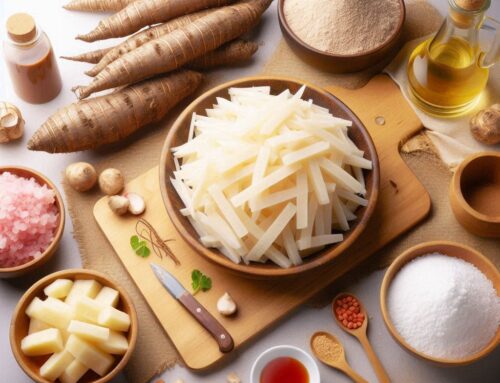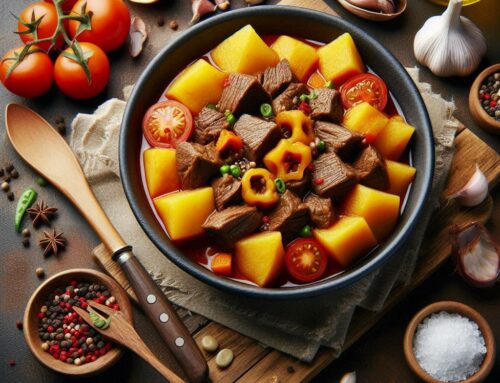
Introduction: Discover the Delights of Fried Cassava Bread
Fried cassava bread is a delightful culinary treasure that has been cherished in many cultures for its rich flavor and satisfying texture. This traditional dish, often enjoyed as a snack or side, showcases the versatility of cassava—a starchy root vegetable known for its adaptability in various recipes. Whether you’re new to cassava recipes or an experienced cook looking to expand your repertoire, homemade fried cassava bread is a must-try.
Preparing this delectable treat involves grating fresh cassava and combining it with simple ingredients to form dough, which is then shaped into small rounds and fried to golden perfection. The result is a crispy exterior that gives way to a soft, chewy interior, making it an irresistible addition to any meal. Fried cassava bread not only highlights the unique qualities of this root vegetable but also pays homage to the traditional cassava dishes enjoyed by generations.
Exploring the world of fried cassava bread opens up a realm of culinary possibilities. It can be served plain or enhanced with spices and herbs for added flavor. Regardless of how you choose to enjoy it, this dish offers an authentic taste experience that celebrates the rich heritage of traditional cooking methods while inviting you to discover new ways to savor one of nature’s most versatile ingredients.
What is Cassava and Why is it a Staple Food in Many Cultures?
Cassava, also known as yuca or manioc, is a root vegetable that holds significant importance in many cultures around the world. Originating from South America, the cassava plant has become a staple food in various tropical regions due to its adaptability and resilience in poor soil conditions. Its ability to thrive where other crops might fail makes it an invaluable resource for food security.
The nutritional value of cassava is one of the reasons it remains a staple food. It is rich in carbohydrates, providing a substantial energy source for millions of people. While cassava itself is low in protein and essential nutrients compared to other staples like rice or wheat, it serves as a crucial calorie source where access to more nutrient-dense foods may be limited. To enhance its nutritional profile, communities often pair cassava with protein-rich foods or fortify it with vitamins and minerals.
Culturally, cassava plays an integral role in the diets and traditions of many societies. In Africa, Asia, and Latin America, it is not only consumed as boiled roots but also processed into various forms such as flour (used for making bread and porridge), tapioca pearls (common in desserts), and fermented products like gari or fufu. These diverse culinary applications highlight its versatility and cultural significance across different regions.
In summary, the widespread cultivation and consumption of cassava can be attributed to its adaptability as a crop, its role as an energy-rich staple food, and its deep cultural roots within many societies worldwide.
Essential Ingredients and Equipment for Making Fried Cassava Bread
When it comes to making fried cassava bread, having the right ingredients and equipment is crucial for achieving that perfect texture and flavor. Let’s dive into what you’ll need to get started.
First and foremost, cassava flour is the star ingredient in this culinary adventure. Known for its versatility, cassava flour provides a gluten-free alternative that’s both nutritious and delicious. Ensure you have fresh cassava flour on hand, as this will serve as the base of your bread.
Next, consider your choice of cooking oil for frying. The oil you select can significantly impact the taste and texture of your bread. Opt for oils with a high smoke point, such as vegetable or canola oil, to ensure even frying without burning.
In addition to these primary ingredients, you’ll need some essential kitchen tools for bread-making. A mixing bowl is necessary for combining ingredients smoothly. A whisk or wooden spoon will help you achieve a consistent batter without lumps.
For frying, a deep pan or skillet is essential to allow enough space for the bread to cook evenly. It’s also wise to have a slotted spoon or tongs handy for safely flipping and removing the bread from hot oil.
Finally, don’t forget about seasoning! While not strictly necessary ingredients like salt or spices can elevate your fried cassava bread by adding layers of flavor that complement its natural taste.
With these essentials at your fingertips—cassava flour, appropriate cooking oil, basic kitchen tools—you’re well-equipped to embark on creating delicious fried cassava bread that’s sure to impress anyone who takes a bite!
A Step-by-Step Recipe for Perfectly Crispy Fried Cassava Bread
Creating perfectly crispy fried cassava bread is a delightful culinary adventure that promises delicious results. This step-by-step cooking guide will walk you through the process, ensuring your cassava bread turns out golden and crunchy every time.
**Ingredients:**
– Cassava flour
– Water
– Salt to taste
– Oil for frying
**Step 1: Prepare the Dough**
Start by mixing cassava flour with a pinch of salt in a large bowl. Gradually add water while stirring until you form a smooth, pliable dough. The consistency should be firm yet elastic, making it easy to roll out.
**Step 2: Shape the Bread**
Divide the dough into small balls and flatten each one into discs about 1/4 inch thick. Ensure they are evenly shaped for uniform frying.
**Step 3: Heat the Oil**
In a deep skillet or frying pan, pour enough oil to cover at least half of the thickness of your bread discs. Heat the oil over medium-high heat until it reaches around 350°F (175°C). You can test this by dropping a small piece of dough into the oil; it should sizzle immediately.
**Step 4: Fry the Bread**
Carefully place each disc into the hot oil without overcrowding. Fry them in batches if necessary. Cook each side for about 2-3 minutes or until they turn golden brown and crispy.
**Step 5: Drain and Serve**
Once cooked, remove the fried cassava bread from the oil using a slotted spoon and place them on paper towels to drain excess oil. Allow them to cool slightly before serving.
By following this recipe, you’ll master how to fry cassava bread with ease, achieving that perfect crispy texture everyone loves. Enjoy your homemade treat as a snack or alongside your favorite dishes!
Troubleshooting Common Issues When Frying Cassava Bread
Frying cassava bread to perfection can be a rewarding culinary experience, but it often comes with its own set of challenges. Understanding how to troubleshoot common frying problems is essential for achieving that crispy, golden texture that makes cassava bread so delightful.
One frequent issue cooks encounter is soggy fried bread. This problem typically arises from either too low a frying temperature or overcrowding the pan. To fix soggy fried bread, ensure your oil is heated to the right temperature—around 350°F (175°C)—before adding the cassava slices. Using a thermometer can help maintain consistent heat. Additionally, avoid overcrowding by frying in small batches; this allows each piece ample space to cook evenly and crisp up properly.
Another common frying problem is uneven cooking, which can result from inconsistent slicing of the cassava bread. To address this, make sure your slices are uniform in thickness before they hit the hot oil; this ensures even cooking and prevents some pieces from becoming overcooked while others remain underdone.
Lastly, if you find your cassava bread absorbing too much oil during frying, it might be due to insufficient drying before cooking. Patting down the sliced cassava with paper towels prior to frying can help minimize excess moisture and reduce oil absorption.
By keeping these troubleshooting tips for cooking with cassava in mind, you can enhance your technique and enjoy perfectly fried cassava bread every time.
Culinary Variations: Experimenting with Flavors and Textures in Your Fried Cassara Bread
Fried cassava bread, also known as cassara bread, offers a delightful canvas for culinary experimentation. By exploring various flavor variations and texture enhancements, you can transform this traditional dish into a unique culinary experience.
One of the simplest ways to introduce new flavors is by incorporating spices directly into the dough. Consider adding aromatic spices such as cumin or coriander for a subtle warmth, or infuse your bread with a hint of heat using chili powder or cayenne pepper. For those who prefer savory notes, garlic powder and onion flakes can add depth to each bite.
Texture experiments in baking fried cassava bread can elevate its appeal even further. To achieve a crispier crust, try dusting the surface with semolina before frying. Alternatively, mixing in small amounts of cornmeal can provide an intriguing crunch that contrasts beautifully with the soft interior.
For adventurous bakers looking to push boundaries even further, consider integrating unexpected ingredients like shredded coconut or finely chopped herbs into the dough. These additions not only enhance flavor but also contribute intriguing textures that make each piece of fried cassava bread uniquely satisfying.
By experimenting with different spices and textures, you can create personalized versions of fried cassava bread that delight both the palate and the senses.






